By Dave Hemenway
Editor’s note: This is the second installment in a series documenting the resurrection of a long-neglected Cape Dory 30. Part 1 is at windcheckmagazine.com/article/deja-vu-all-over-again/
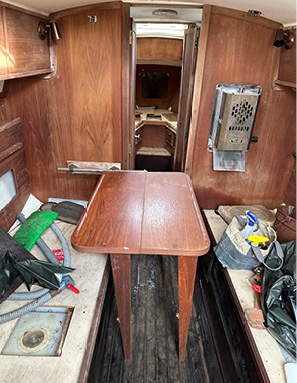 The first order of business was to clean Moonshadow, remove everything from the boat, and let her dry out. All the interior wood was wet and had been for many years. I could not determine the interior’s condition until it returned to its normal dry state which took a couple weeks. I was amazed how little damage there was to the interior wood. The cabin sole will need to be replaced, but is serviceable for this summer. While several pieces of plywood had delaminated, the bulkheads were fine and all the teak trim was fine, which was a nice surprise.
The first order of business was to clean Moonshadow, remove everything from the boat, and let her dry out. All the interior wood was wet and had been for many years. I could not determine the interior’s condition until it returned to its normal dry state which took a couple weeks. I was amazed how little damage there was to the interior wood. The cabin sole will need to be replaced, but is serviceable for this summer. While several pieces of plywood had delaminated, the bulkheads were fine and all the teak trim was fine, which was a nice surprise.
Since my primary goal was to make her float-worthy, I needed to inspect the thru-hulls. I quickly determined that the old head and waste storage system had to be removed and replaced with a composting toilet. This enabled me to remove the head water intake and head waste discharge thru-hulls in addition to the holding tank which was in excellent shape. I removed these items and found another Cape Dory 30 owner who wanted the waste storage tank which I gladly gave him. I removed the two seacocks by grinding off the thru-hulls heads and twisting the seacock with the remaining seacock stems from the inside using a 14” pipe wrench. The Spartan seacocks were not harmed and I will use them for other projects or rehome them.)
The engine raw water input seacock and the sink drain were accessible from the forward engine compartment. I was able to loosen them up by gently tapping the cone nuts with a small hammer and then I easily serviced them.
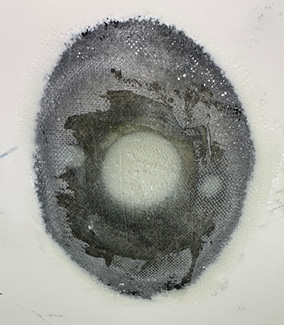
My next step was to crawl into the cockpit lockers and photograph what was under the cockpit. I discovered the remaining frozen seacocks thru-hulls, the wheel steering mechanism, and the engine controls in addition to a steel post that supported the front half of the cockpit floor. One of my primary goals for this project was to simplify maintenance issues. I needed to have access to all areas of the boat. The primary criticism of these boats is that there is VERY limited access to the engine, cockpit thru-hulls and steering gear. I also wanted to be able to hand start the two-cylinder Volvo diesel which has a decompression lever and a crank arrangement that was under the cockpit.
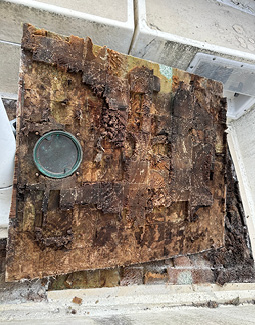
Since the cockpit’s core was completely rotten, I decided to rebuild the cockpit with a hatch which would solve these challenges.
I removed the outer layer of the front half of the cockpit floor using a reciprocal saw that worked very well. I found all the balsa core had completely decomposed and the only thing supporting the cockpit floor was the steel post. I carefully removed the inner layer of the forward cockpit floor and determined that I could make a nice 24” wide by 26” long cockpit hatch that would provide access to all the equipment that was formerly inaccessible. This was great since I could now easily service the seacocks and replace all the original hoses.

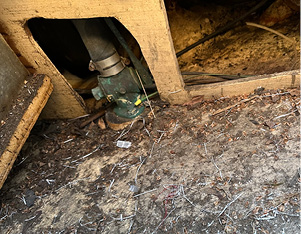
I framed up the new hatch, making sure that there was good cockpit drainage. The new hatch is ½” plywood with 1½” supports built into it. Everything is epoxy coated and the hatch is covered with one layer of heavy fiberglass and one layer of Dynel set in WEST epoxy. I am very pleased with this modification, and now have great access to everything under the cockpit.
Moonshadow had her original Edson pedestal wheel that was beginning to show its age. Since I much prefer a tiller to a wheel, I removed the old pedestal gear and replaced it with a tiller which is much simpler to service, has improved steering precision, and is easily adaptable to self-steering with an electric autopilot and/or a windvane.
The rear section of the cockpit floor was removed to replace its rotten core and was replaced with ½” plywood which was covered with a layer of heavy fiberglass with a Dynel top layer.
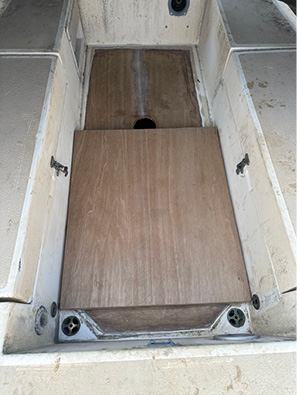
Moonshadow’s rudder was frozen in place. Once I removed the old pedestal steering system, I determined the problem was that the rudder shaft and the lower gudgeon had a close relationship that was dissolved by repeated doses of penetrating oil over a couple weeks. While the rudder is still stiff, it now moves and is slowly loosening up.
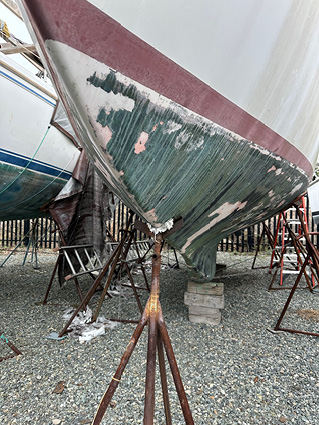
My next challenge was preparing the bottom for painting. I decided to remove all the 35-year-old, flaking paint to determine its condition. This took approximately seventy hours using a sharp one-inch chisel and then using 100 grit sandpaper on a sander attached to a HEPA-rated vacuum. Moonshadow’s bottom is now in excellent condition with only a few minor repairs needed.
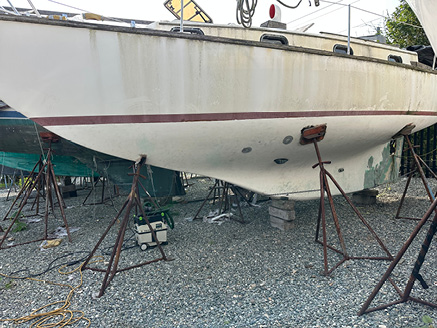
I have worked about six weeks on this project and while I’m pleased with the results, it has been difficult working away from my shop and being at the mercy of the marina’s schedule. By the time you read this article, Moonshadow will be back in the water and on her Thames River mooring where I can continue her restoration. While there is still much work to be done, I look forward to restoring this good old boat. ■
Dave Hemenway, Northeast fleet captain of the Cape Dory Sailboat Owners Association, lives in Eastern Connecticut and sails out of Boating on the Thames in New London. He’s been sailing and messing about in boats for his whole life and has recreationally sailed Finns on and off since the 1970s. His primary cruising boat is a Dickerson 36 yawl that he’s maintained and improved for 35 years. Since retiring from higher education, he has worked at Cappy’s Boat Shop where he reports to his dog, Cappy.



